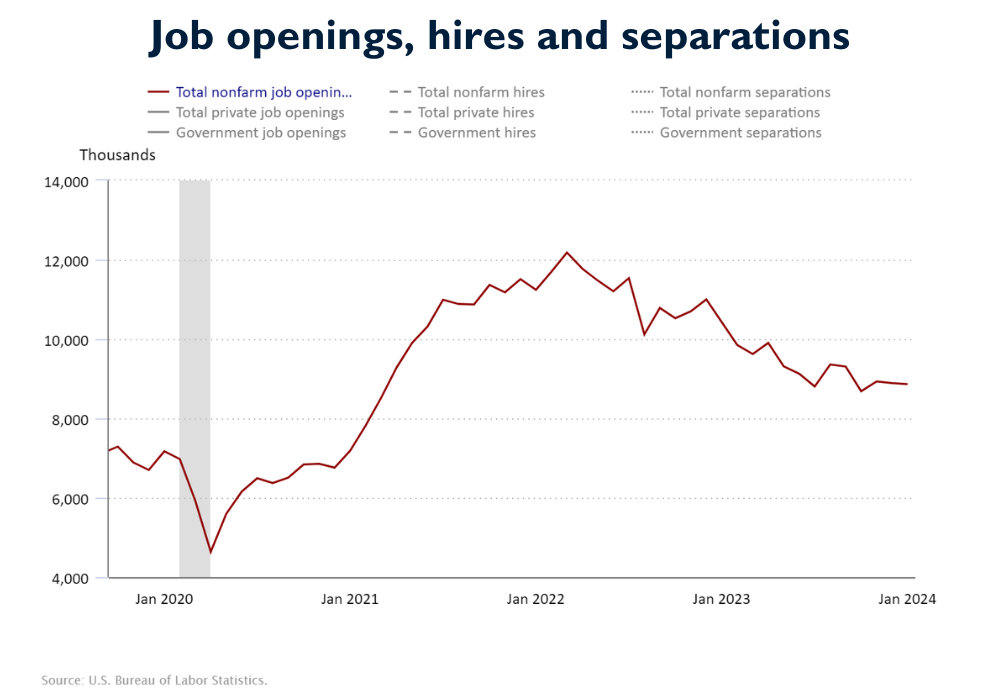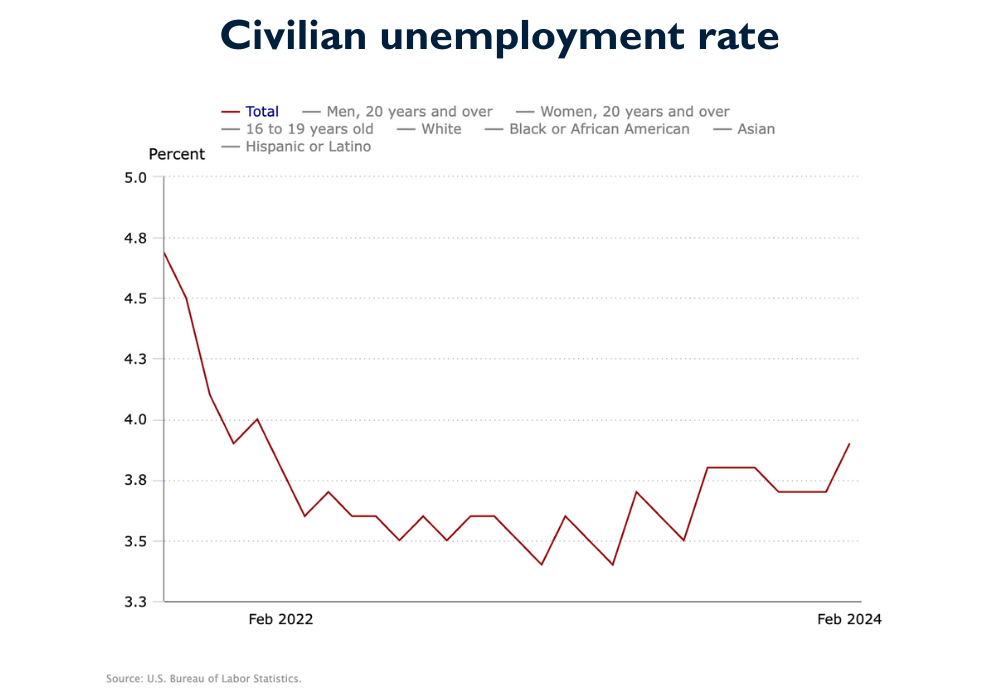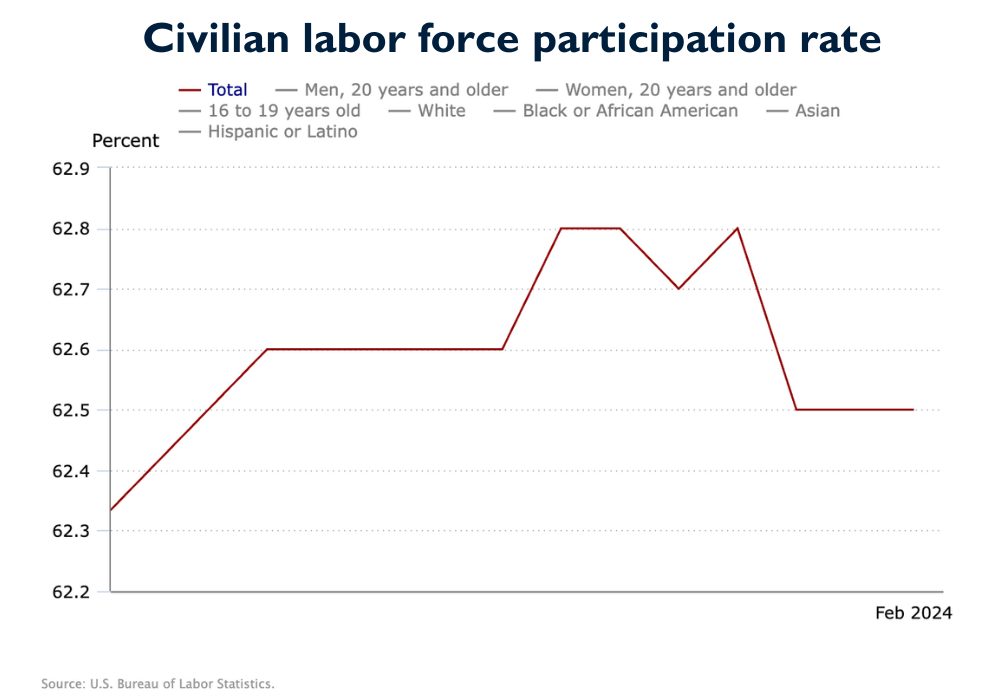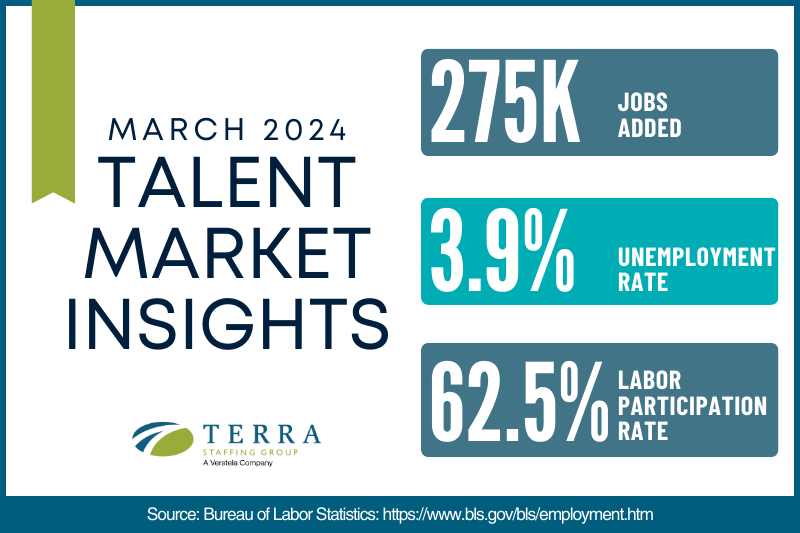March 2024 Talent Market Insights
Posted on March 14, 2024
On the surface, February was in many ways, “typical.”
This was another month of strong job growth, and little changed in workforce participation and unemployment.
But if you look closer at the data, the economic landscape isn’t quite as it appears at first glance. Despite consistently strong job gains, right now, employers and employees are feeling the effects of a market that is tightening.
We’ll discuss what’s going on in the labor market and what this means for businesses.
Key takeaways:
- 275,000 jobs were added in February.
- The unemployment rate rose by 0.2%.
- Workforce participation remains stagnant.
- Headline-making mass layoffs continued throughout February.
Number of Jobs Available

In February, leading industries in job growth were healthcare (+67,000), government (+52,000) and food service (+42,000).
January and December’s job gains were revised down by 167,000 combined. January’s job gains are now an estimated 229,000 (below reported 353,000) and December’s job gains are now 290,000 (below reported 333,000).
The latest JOLTS report showed that job openings decreased slightly from 9 million to 8.9 million in January.
It’s predicted that more healthcare workers will be needed as many baby boomers continue to retire.
Overall, job gains remain consistently strong month over month. However, some view these gains as “rosy,” indicating these strong numbers do not accurately reflect what workers and employers are experiencing in the economy.
Unemployment

Unemployment rose from 3.7% to 3.9%, cementing the 25th consecutive month of the unemployment rate remaining below 4%.
Yet, mass layoffs continued to occur in the tech industry in February. Companies such as Cisco and DocuSign made significant reductions to their workforce. And in total, U.S. employers announced nearly 85,000 cuts to their workforce—the highest number of layoffs since 2009, during the mortgage crisis recession.
Unemployed workers are finding it increasingly difficult to land a job, despite widening their search outside of their chosen field. Meanwhile, employers are becoming more reluctant to hire, as they may be more concerned over turnover resulting from The Great Resignation, as well as wage increases contributing to expensive hires.
Workforce Participation

Workforce participation remained at 62.5% for the third consecutive month.
People employed part time for economic reasons changed little, at 4.4 million.
The number of new hires—which has remained below the pre-pandemic level of 5.9 million since November—have increased slightly in January, from 5.6 million to 5.7 million in the latest JOLTS report. And the number of quits remained at 3.4 million.
Another stagnant month for workforce participation could be another month showing signs of The Big Stay—the phenomenon in response to The Great Resignation where employees are more reluctant to leave their jobs. Except now we’re seeing more stagnant behavior from employers, too. The lower levels of new hires are showing what employers are not doing: hiring.
Economic Variables to Keep an Eye On
- Inflation (and Federal Reserve Decisions). The Fed will meet again on March 20th to decide what will happen with interest rates in their effort to curb inflation.
- Wage growth. Wages increased slightly by 0.1%, just one-tenth of a percentage point below what was predicted and could influence the Federal Reserve’s decision around interest rates.
- Consumer spending. The latest consumer price index report (CPI) released mid-February showed an overall 0.3% increase in the cost of goods in January, which may impact future spending.
Winning Moves for Employers
In any market, having top talent on your team is a winning strategy.
Here are some effective tips to maintain a competitive edge:
- Consider temporary staffing. Regardless of market conditions, temporary staffing is a flexible, budget-friendly strategy to help businesses navigate fluctuations in staffing demands, meet project deadlines, and meet productivity goals.
- Remain attractive to talent. There are things employers can do to attract talent beyond pay and benefits. Ensure your workplace is an environment where employees feel they can make a difference and grow their careers. Offer training, advancement and unique perks to both attract and retain employees.
- Engage your current employees. Ensure employees feel supported, valued and heard. Create an environment where team members are encouraged and empowered to speak up and contribute their ideas. Engaged employees make more meaningful contributions AND they’re happier which is a win-win.
Looking for more resources? Check out our employer resource center. We have an archive of on-demand HR webinars, tools and articles to help you navigate various workplace challenges.
Feel free to contact us for insights into market trends and help with your staffing needs.
Categories: Staffing Tips & Recruiting Trends
Tags: job market data, labor market trends, Talent Market Insights, Talent Market Insights March 2024





